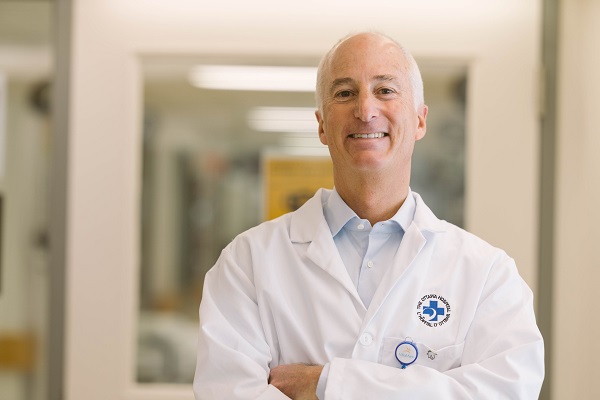World-first trial shows benefits of finding, treating undiagnosed asthma and COPD
 "It's estimated that 70 per cent of people with asthma or COPD go undiagnosed. This is the first study to prove that treating those people makes a real difference to their health and quality of life." -Dr. Shawn AaronFinding and treating people with undiagnosed asthma or chronic obstructive pulmonary disease (COPD) improved their health and reduced their healthcare visits for respiratory symptoms in the year after diagnosis, according to a world-first clinical trial published in the New England Journal of Medicine.
"It's estimated that 70 per cent of people with asthma or COPD go undiagnosed. This is the first study to prove that treating those people makes a real difference to their health and quality of life." -Dr. Shawn AaronFinding and treating people with undiagnosed asthma or chronic obstructive pulmonary disease (COPD) improved their health and reduced their healthcare visits for respiratory symptoms in the year after diagnosis, according to a world-first clinical trial published in the New England Journal of Medicine.
"It's estimated that 70 per cent of people with asthma or COPD go undiagnosed." said study lead Dr. Shawn Aaron, a senior scientist and lung specialist at The Ottawa Hospital and professor at the University of Ottawa. "This is the first study to prove that treating those people makes a real difference to their health and quality of life."
How did the research team find undiagnosed cases?
To find people with undiagnosed asthma and COPD, the research team called random phone numbers at 17 study sites across Canada from 2017 to 2023. An automated call asked whether any adults in the household had unexplained shortness of breath, wheezing, prolonged cough or were coughing up mucus in the past six months.
The 26,905 people who reported these symptoms completed questionnaires. Those most likely to have asthma or COPD did a spirometry breathing test, the gold standard for diagnosis.
A total of 595 people were diagnosed with either asthma or COPD, and 508 agreed to participate in a randomized controlled trial to compare different types of care.
Half the people in the trial were randomly assigned to usual care (care provided by their primary care provider or a walk-in-clinic), while the other half were treated by a lung specialist and asthma/COPD educator (a specially-trained nurse or respiratory therapist).
Individuals treated by a lung specialist and educator were prescribed inhalers to treat their asthma or COPD and were taught how to use them. Some were given action plans to help them manage disease flare-ups themselves. They were provided with smoking cessation treatment, exercise and weight counselling, and pneumonia and flu vaccines if appropriate.
Ninety-two per cent of patients seen by a lung specialist and asthma/COPD educator started new medications for asthma or COPD, compared to 60 per cent of patients who received usual care.
Treating undiagnosed asthma, COPD leads to fewer healthcare visits
The researchers found that patients seen by a lung specialist and asthma/COPD educator averaged 0.53 healthcare visits per year for respiratory symptoms in the year after diagnosis, compared to 1.12 visits in the usual care group.
In addition, patients seen by a lung specialist and asthma/COPD educator saw their average score on the St. George's Respiratory Questionnaire rise by 10.2 points, compared to 6.8 points for the usual care group. A four-point rise means an improvement in health and quality of life.
"In the real world, not everyone can see a lung specialist," explains Dr. Aaron. "The good news is that as long as a patient gets diagnosed and treated, their symptoms will improve. The people in our study who went to primary care providers and walk-in clinics had great outcomes, and those who went to a lung specialist and asthma/COPD educator had excellent outcomes."
"Asthma diagnosis makes a big difference," says study participant
_400.jpg) "The asthma diagnosis makes a big difference. I've noticed an increase in energy. I have two small kids now and I can keep up with them. I sleep better because I used to regularly wake up struggling to breathe." - study participant Jazzminn HeinJazzminn Hein was 24 years old and had recently given birth to her first child when she got the call inviting her to join the study. Carrying a few loads of laundry up the stairs or talking on the phone for 10 minutes would leave her breathless. She didn't see the downside to getting a breathing test.
"The asthma diagnosis makes a big difference. I've noticed an increase in energy. I have two small kids now and I can keep up with them. I sleep better because I used to regularly wake up struggling to breathe." - study participant Jazzminn HeinJazzminn Hein was 24 years old and had recently given birth to her first child when she got the call inviting her to join the study. Carrying a few loads of laundry up the stairs or talking on the phone for 10 minutes would leave her breathless. She didn't see the downside to getting a breathing test.
"For years I told doctors about this elephant on my chest and struggling to breathe. They said it was my anxiety, that I was having panic attacks." remembers Jazzminn.
But it wasn't panic attacks. It was asthma. Asthma that she'd likely had since grade school. A daily inhaler turned her symptoms around.
"The asthma diagnosis makes a big difference," she says. "Your muscles need oxygen, and when you can't breathe properly it makes you sore and tired all the time. I've noticed an increase in energy. I have two small kids now and I can keep up with them. I sleep better because I used to regularly wake up struggling to breathe."
Asthma affects eight per cent of Canadian adults and can develop at any age, while COPD affects eight per cent of Canadians over the age of 60.
"If you have breathing symptoms like mine, go to your doctor or a walk-in clinic and ask for a spirometry test," recommends Jazzminn. "The worst that can happen is that you'll have wasted your time. But if you do have a respiratory disease and get it properly treated, you'll be able to do things you hadn't realized you missed."
Dr. Aaron agrees with Jazzminn. He thinks the best way to catch more cases of undiagnosed asthma and COPD is for patients to advocate for themselves. His past research found that even early stages of these diseases are linked with worse quality of life, greater healthcare use and decreased work productivity.
"Many people know to ask for breast cancer and colon cancer tests when they see certain signs. Ideally, they'd ask for a spirometry test when they notice symptoms of chronic respiratory diseases," says Dr. Aaron. "People don't have to put up with these breathing problems when there is effective treatment available."
Full reference: Early Diagnosis and Treatment of COPD and Asthma: A Randomized, Controlled Trial. Shawn D. Aaron, Katherine L. Vandemheen, G. A. Whitmore, Celine Bergeron, Louis-Philippe Boulet, Andreanne Cote, Andrew McIvor, Erika Penz, Stephen K. Field, Catherine Lemière, Irvin Mayers, Mohit Bhutani, Tanweer Azher, Diane Lougheed, Samir Gupta, Nicole Ezer, Christopher J. Licskai, Paul Hernandez, Martha Ainslie, Gonzalo G Alvarez, Sunita Mulpuru, for the UCAP investigators. New England Journal of Medicine. May 19, 2024. DOI: 10.1056/NEJMoa2401389
Funding: This study was funded by the Canadian Institutes of Health Research.
The Ottawa Hospital (TOH) is one of Canada's top learning and research hospitals where we are guided by our vision to provide the world-class and compassionate care we would all want for our loved ones. Our multi-campus hospital, affiliated with the University of Ottawa, is home to the Regional Trauma Centre and Cancer Centre, and to discoveries that are adopted globally. Backed by generous support from the community, we are focused on reshaping the future of health care to improve the health of our diverse population of patients from Eastern Ontario, Western Quebec, and Nunavut. For more information, visit?ohri.ca.
The University of Ottawa is home to over 50,000 students, faculty and staff, who live, work and study in both French and English. Our campus is a crossroads of cultures and ideas, where bold minds come together to inspire game-changing ideas. We are one of Canada's top 10 research universities--our professors and researchers explore new approaches to today's challenges. One of a handful of Canadian universities ranked among the top 200 in the world, we attract exceptional thinkers and welcome diverse perspectives from across the globe. www.uottawa.ca
Jennifer Ganton
Director, Communications and Public Relations
Ottawa Hospital Research Institute
613-614-5253
jganton@ohri.ca
Learn more about:
The Ottawa Hospital is a leading academic health, research and learning hospital proudly affiliated with the University of Ottawa and supported by The Ottawa Hospital Foundation.


